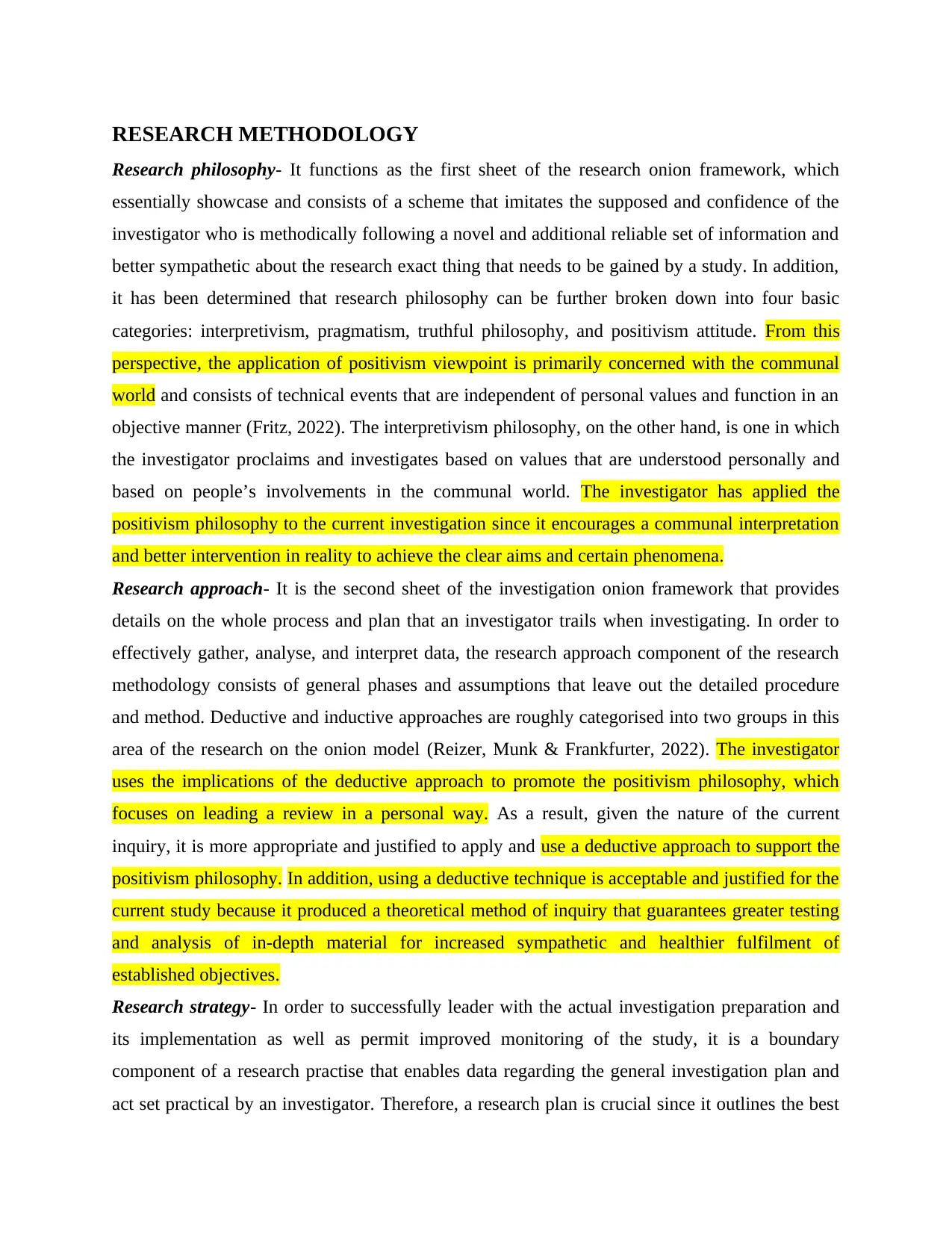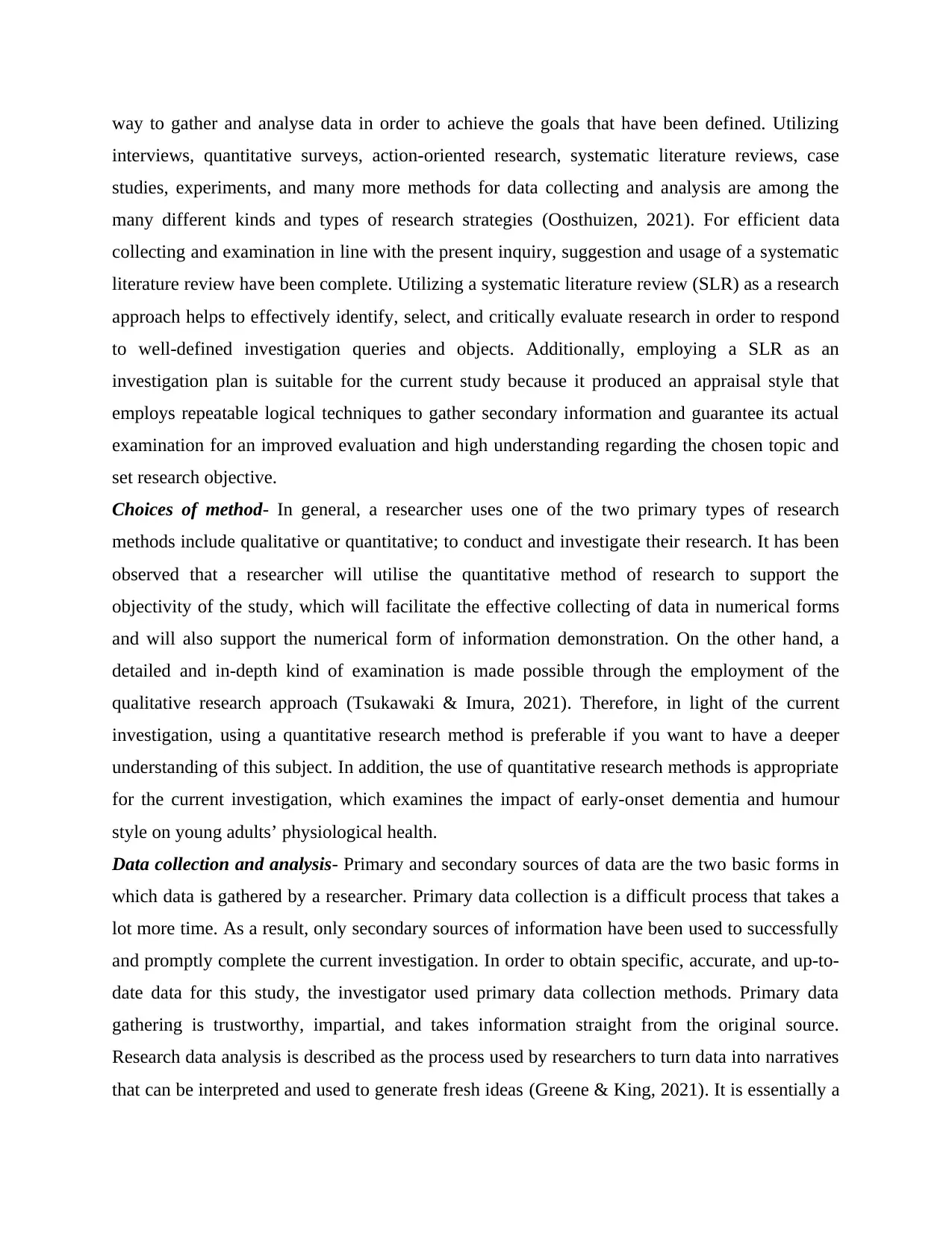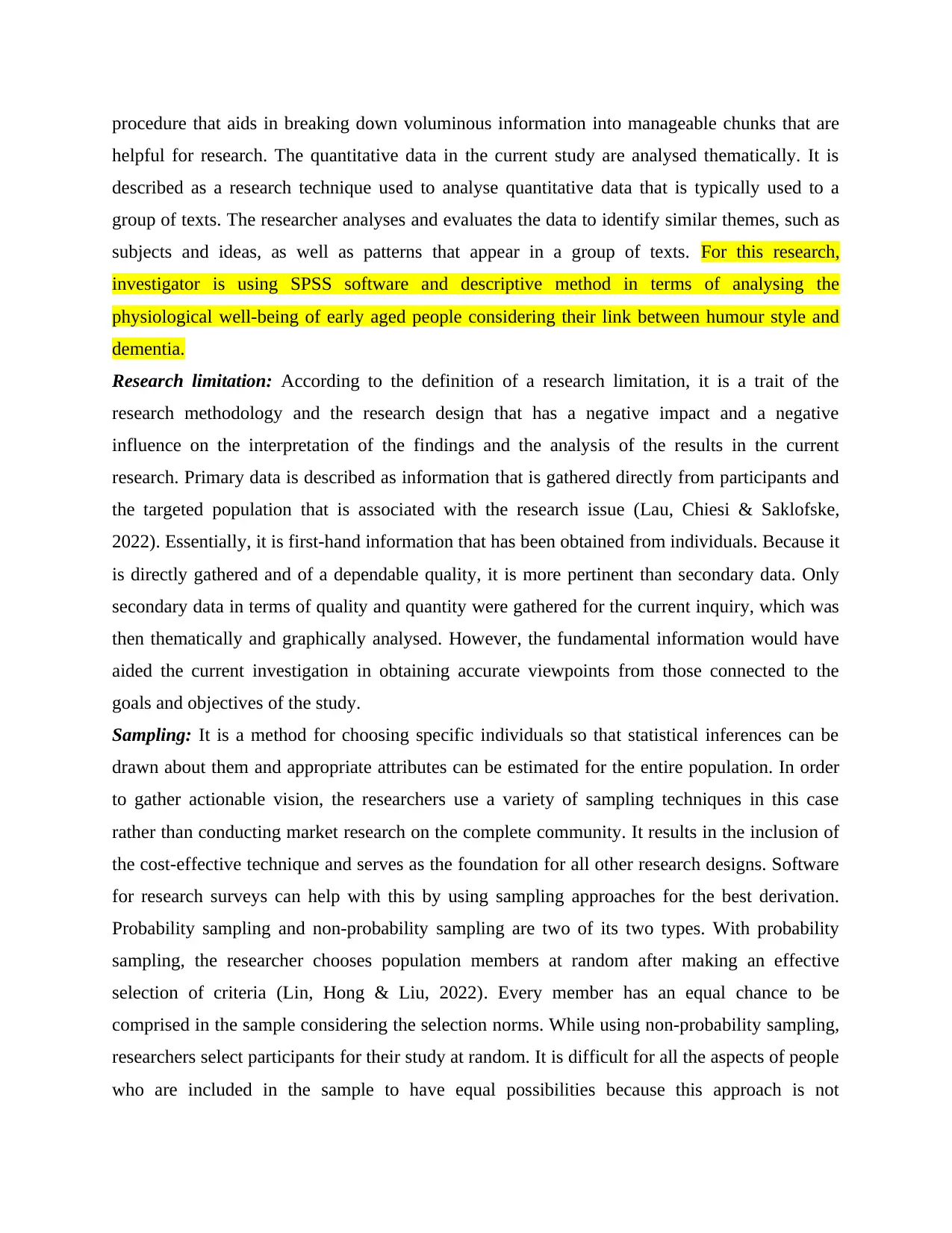Research Methodology Report: Humor Style and Physiological Well-being
VerifiedAdded on 2023/01/18
|7
|2173
|42
Report
AI Summary
This report delves into the research methodology employed to investigate the relationship between humor styles and physiological well-being. It begins with an overview of the research philosophy, specifically positivism, and the deductive approach adopted to guide the study. The research strategy utilizes a systematic literature review for data collection and analysis. The report justifies the use of a quantitative research method, highlighting the choice of data collection from secondary sources. It details the thematic analysis of quantitative data using SPSS software. The report also addresses research limitations, sampling techniques, including inclusion and exclusion criteria, and ethical considerations such as confidentiality and data integrity. Finally, it includes planning and feasibility aspects like Gantt chart and timeline, and a comprehensive list of references.

Humour style and
physiological well
being
physiological well
being
Paraphrase This Document
Need a fresh take? Get an instant paraphrase of this document with our AI Paraphraser


RESEARCH METHODOLOGY
Research philosophy- It functions as the first sheet of the research onion framework, which
essentially showcase and consists of a scheme that imitates the supposed and confidence of the
investigator who is methodically following a novel and additional reliable set of information and
better sympathetic about the research exact thing that needs to be gained by a study. In addition,
it has been determined that research philosophy can be further broken down into four basic
categories: interpretivism, pragmatism, truthful philosophy, and positivism attitude. From this
perspective, the application of positivism viewpoint is primarily concerned with the communal
world and consists of technical events that are independent of personal values and function in an
objective manner (Fritz, 2022). The interpretivism philosophy, on the other hand, is one in which
the investigator proclaims and investigates based on values that are understood personally and
based on people’s involvements in the communal world. The investigator has applied the
positivism philosophy to the current investigation since it encourages a communal interpretation
and better intervention in reality to achieve the clear aims and certain phenomena.
Research approach- It is the second sheet of the investigation onion framework that provides
details on the whole process and plan that an investigator trails when investigating. In order to
effectively gather, analyse, and interpret data, the research approach component of the research
methodology consists of general phases and assumptions that leave out the detailed procedure
and method. Deductive and inductive approaches are roughly categorised into two groups in this
area of the research on the onion model (Reizer, Munk & Frankfurter, 2022). The investigator
uses the implications of the deductive approach to promote the positivism philosophy, which
focuses on leading a review in a personal way. As a result, given the nature of the current
inquiry, it is more appropriate and justified to apply and use a deductive approach to support the
positivism philosophy. In addition, using a deductive technique is acceptable and justified for the
current study because it produced a theoretical method of inquiry that guarantees greater testing
and analysis of in-depth material for increased sympathetic and healthier fulfilment of
established objectives.
Research strategy- In order to successfully leader with the actual investigation preparation and
its implementation as well as permit improved monitoring of the study, it is a boundary
component of a research practise that enables data regarding the general investigation plan and
act set practical by an investigator. Therefore, a research plan is crucial since it outlines the best
Research philosophy- It functions as the first sheet of the research onion framework, which
essentially showcase and consists of a scheme that imitates the supposed and confidence of the
investigator who is methodically following a novel and additional reliable set of information and
better sympathetic about the research exact thing that needs to be gained by a study. In addition,
it has been determined that research philosophy can be further broken down into four basic
categories: interpretivism, pragmatism, truthful philosophy, and positivism attitude. From this
perspective, the application of positivism viewpoint is primarily concerned with the communal
world and consists of technical events that are independent of personal values and function in an
objective manner (Fritz, 2022). The interpretivism philosophy, on the other hand, is one in which
the investigator proclaims and investigates based on values that are understood personally and
based on people’s involvements in the communal world. The investigator has applied the
positivism philosophy to the current investigation since it encourages a communal interpretation
and better intervention in reality to achieve the clear aims and certain phenomena.
Research approach- It is the second sheet of the investigation onion framework that provides
details on the whole process and plan that an investigator trails when investigating. In order to
effectively gather, analyse, and interpret data, the research approach component of the research
methodology consists of general phases and assumptions that leave out the detailed procedure
and method. Deductive and inductive approaches are roughly categorised into two groups in this
area of the research on the onion model (Reizer, Munk & Frankfurter, 2022). The investigator
uses the implications of the deductive approach to promote the positivism philosophy, which
focuses on leading a review in a personal way. As a result, given the nature of the current
inquiry, it is more appropriate and justified to apply and use a deductive approach to support the
positivism philosophy. In addition, using a deductive technique is acceptable and justified for the
current study because it produced a theoretical method of inquiry that guarantees greater testing
and analysis of in-depth material for increased sympathetic and healthier fulfilment of
established objectives.
Research strategy- In order to successfully leader with the actual investigation preparation and
its implementation as well as permit improved monitoring of the study, it is a boundary
component of a research practise that enables data regarding the general investigation plan and
act set practical by an investigator. Therefore, a research plan is crucial since it outlines the best
⊘ This is a preview!⊘
Do you want full access?
Subscribe today to unlock all pages.

Trusted by 1+ million students worldwide

way to gather and analyse data in order to achieve the goals that have been defined. Utilizing
interviews, quantitative surveys, action-oriented research, systematic literature reviews, case
studies, experiments, and many more methods for data collecting and analysis are among the
many different kinds and types of research strategies (Oosthuizen, 2021). For efficient data
collecting and examination in line with the present inquiry, suggestion and usage of a systematic
literature review have been complete. Utilizing a systematic literature review (SLR) as a research
approach helps to effectively identify, select, and critically evaluate research in order to respond
to well-defined investigation queries and objects. Additionally, employing a SLR as an
investigation plan is suitable for the current study because it produced an appraisal style that
employs repeatable logical techniques to gather secondary information and guarantee its actual
examination for an improved evaluation and high understanding regarding the chosen topic and
set research objective.
Choices of method- In general, a researcher uses one of the two primary types of research
methods include qualitative or quantitative; to conduct and investigate their research. It has been
observed that a researcher will utilise the quantitative method of research to support the
objectivity of the study, which will facilitate the effective collecting of data in numerical forms
and will also support the numerical form of information demonstration. On the other hand, a
detailed and in-depth kind of examination is made possible through the employment of the
qualitative research approach (Tsukawaki & Imura, 2021). Therefore, in light of the current
investigation, using a quantitative research method is preferable if you want to have a deeper
understanding of this subject. In addition, the use of quantitative research methods is appropriate
for the current investigation, which examines the impact of early-onset dementia and humour
style on young adults’ physiological health.
Data collection and analysis- Primary and secondary sources of data are the two basic forms in
which data is gathered by a researcher. Primary data collection is a difficult process that takes a
lot more time. As a result, only secondary sources of information have been used to successfully
and promptly complete the current investigation. In order to obtain specific, accurate, and up-to-
date data for this study, the investigator used primary data collection methods. Primary data
gathering is trustworthy, impartial, and takes information straight from the original source.
Research data analysis is described as the process used by researchers to turn data into narratives
that can be interpreted and used to generate fresh ideas (Greene & King, 2021). It is essentially a
interviews, quantitative surveys, action-oriented research, systematic literature reviews, case
studies, experiments, and many more methods for data collecting and analysis are among the
many different kinds and types of research strategies (Oosthuizen, 2021). For efficient data
collecting and examination in line with the present inquiry, suggestion and usage of a systematic
literature review have been complete. Utilizing a systematic literature review (SLR) as a research
approach helps to effectively identify, select, and critically evaluate research in order to respond
to well-defined investigation queries and objects. Additionally, employing a SLR as an
investigation plan is suitable for the current study because it produced an appraisal style that
employs repeatable logical techniques to gather secondary information and guarantee its actual
examination for an improved evaluation and high understanding regarding the chosen topic and
set research objective.
Choices of method- In general, a researcher uses one of the two primary types of research
methods include qualitative or quantitative; to conduct and investigate their research. It has been
observed that a researcher will utilise the quantitative method of research to support the
objectivity of the study, which will facilitate the effective collecting of data in numerical forms
and will also support the numerical form of information demonstration. On the other hand, a
detailed and in-depth kind of examination is made possible through the employment of the
qualitative research approach (Tsukawaki & Imura, 2021). Therefore, in light of the current
investigation, using a quantitative research method is preferable if you want to have a deeper
understanding of this subject. In addition, the use of quantitative research methods is appropriate
for the current investigation, which examines the impact of early-onset dementia and humour
style on young adults’ physiological health.
Data collection and analysis- Primary and secondary sources of data are the two basic forms in
which data is gathered by a researcher. Primary data collection is a difficult process that takes a
lot more time. As a result, only secondary sources of information have been used to successfully
and promptly complete the current investigation. In order to obtain specific, accurate, and up-to-
date data for this study, the investigator used primary data collection methods. Primary data
gathering is trustworthy, impartial, and takes information straight from the original source.
Research data analysis is described as the process used by researchers to turn data into narratives
that can be interpreted and used to generate fresh ideas (Greene & King, 2021). It is essentially a
Paraphrase This Document
Need a fresh take? Get an instant paraphrase of this document with our AI Paraphraser

procedure that aids in breaking down voluminous information into manageable chunks that are
helpful for research. The quantitative data in the current study are analysed thematically. It is
described as a research technique used to analyse quantitative data that is typically used to a
group of texts. The researcher analyses and evaluates the data to identify similar themes, such as
subjects and ideas, as well as patterns that appear in a group of texts. For this research,
investigator is using SPSS software and descriptive method in terms of analysing the
physiological well-being of early aged people considering their link between humour style and
dementia.
Research limitation: According to the definition of a research limitation, it is a trait of the
research methodology and the research design that has a negative impact and a negative
influence on the interpretation of the findings and the analysis of the results in the current
research. Primary data is described as information that is gathered directly from participants and
the targeted population that is associated with the research issue (Lau, Chiesi & Saklofske,
2022). Essentially, it is first-hand information that has been obtained from individuals. Because it
is directly gathered and of a dependable quality, it is more pertinent than secondary data. Only
secondary data in terms of quality and quantity were gathered for the current inquiry, which was
then thematically and graphically analysed. However, the fundamental information would have
aided the current investigation in obtaining accurate viewpoints from those connected to the
goals and objectives of the study.
Sampling: It is a method for choosing specific individuals so that statistical inferences can be
drawn about them and appropriate attributes can be estimated for the entire population. In order
to gather actionable vision, the researchers use a variety of sampling techniques in this case
rather than conducting market research on the complete community. It results in the inclusion of
the cost-effective technique and serves as the foundation for all other research designs. Software
for research surveys can help with this by using sampling approaches for the best derivation.
Probability sampling and non-probability sampling are two of its two types. With probability
sampling, the researcher chooses population members at random after making an effective
selection of criteria (Lin, Hong & Liu, 2022). Every member has an equal chance to be
comprised in the sample considering the selection norms. While using non-probability sampling,
researchers select participants for their study at random. It is difficult for all the aspects of people
who are included in the sample to have equal possibilities because this approach is not
helpful for research. The quantitative data in the current study are analysed thematically. It is
described as a research technique used to analyse quantitative data that is typically used to a
group of texts. The researcher analyses and evaluates the data to identify similar themes, such as
subjects and ideas, as well as patterns that appear in a group of texts. For this research,
investigator is using SPSS software and descriptive method in terms of analysing the
physiological well-being of early aged people considering their link between humour style and
dementia.
Research limitation: According to the definition of a research limitation, it is a trait of the
research methodology and the research design that has a negative impact and a negative
influence on the interpretation of the findings and the analysis of the results in the current
research. Primary data is described as information that is gathered directly from participants and
the targeted population that is associated with the research issue (Lau, Chiesi & Saklofske,
2022). Essentially, it is first-hand information that has been obtained from individuals. Because it
is directly gathered and of a dependable quality, it is more pertinent than secondary data. Only
secondary data in terms of quality and quantity were gathered for the current inquiry, which was
then thematically and graphically analysed. However, the fundamental information would have
aided the current investigation in obtaining accurate viewpoints from those connected to the
goals and objectives of the study.
Sampling: It is a method for choosing specific individuals so that statistical inferences can be
drawn about them and appropriate attributes can be estimated for the entire population. In order
to gather actionable vision, the researchers use a variety of sampling techniques in this case
rather than conducting market research on the complete community. It results in the inclusion of
the cost-effective technique and serves as the foundation for all other research designs. Software
for research surveys can help with this by using sampling approaches for the best derivation.
Probability sampling and non-probability sampling are two of its two types. With probability
sampling, the researcher chooses population members at random after making an effective
selection of criteria (Lin, Hong & Liu, 2022). Every member has an equal chance to be
comprised in the sample considering the selection norms. While using non-probability sampling,
researchers select participants for their study at random. It is difficult for all the aspects of people
who are included in the sample to have equal possibilities because this approach is not

established for the selection process. Within this research, particular group of homogenous
patient population is opted. It includes inclusion and exclusion that define who can be included
or excluded from the study sample. The inclusion criteria analyse the study population in
consistent, uniform and reliable manner. Further, the exclusion includes factors that make the
recruited population ineligible for research. In this study, the researcher uses probability
sampling or inclusion criteria and considers 300 participants, including doctors, users of social
media, and others. The sample choice demonstrates the researcher’s thorough comprehension. As
the sample precisely showcase the entire population, this sample results in higher-quality
information collecting.
Key ethical issues
Research ethics is defined as the ethical principles that the investigator considers while carrying
out every research in a moral and legal manner. When conducting the research, the investigator
must adhere to a number of different forms of research ethics. The researcher must take
information confidentiality into account when doing their investigation. Additionally, harm to
anyone, including humans and animals, is another study ethics issue that the researcher must
consider. Researchers have mostly considered this form of study ethics that there should be no
harm done to any persons or animals, either physically, socially, or psychologically, in order to
conduct the investigation in an ethical and legal manner (Cheng, 2021). In order to prevent
research misconduct and accurately portray the results, it is the researcher’s duty to deliver the
findings to the reader in a manner free of plagiarism. Along with data integrity, conflict of
interest, and respect and justice, the investigator also takes these factors into account when doing
research. Along with maintaining the scientific validity and ethical subject selection, the
researcher has also preserved the social and clinical significance of the work. The current
investigation is a wholly impartial evaluation that is sincere and respectful of the subjects and the
research issues that have been found during the study. Hence, it is important for the researcher to
conduct research in an effective manner by considering every ethical perspective.
Planning and feasibility (Gantt Chart and timeline)
patient population is opted. It includes inclusion and exclusion that define who can be included
or excluded from the study sample. The inclusion criteria analyse the study population in
consistent, uniform and reliable manner. Further, the exclusion includes factors that make the
recruited population ineligible for research. In this study, the researcher uses probability
sampling or inclusion criteria and considers 300 participants, including doctors, users of social
media, and others. The sample choice demonstrates the researcher’s thorough comprehension. As
the sample precisely showcase the entire population, this sample results in higher-quality
information collecting.
Key ethical issues
Research ethics is defined as the ethical principles that the investigator considers while carrying
out every research in a moral and legal manner. When conducting the research, the investigator
must adhere to a number of different forms of research ethics. The researcher must take
information confidentiality into account when doing their investigation. Additionally, harm to
anyone, including humans and animals, is another study ethics issue that the researcher must
consider. Researchers have mostly considered this form of study ethics that there should be no
harm done to any persons or animals, either physically, socially, or psychologically, in order to
conduct the investigation in an ethical and legal manner (Cheng, 2021). In order to prevent
research misconduct and accurately portray the results, it is the researcher’s duty to deliver the
findings to the reader in a manner free of plagiarism. Along with data integrity, conflict of
interest, and respect and justice, the investigator also takes these factors into account when doing
research. Along with maintaining the scientific validity and ethical subject selection, the
researcher has also preserved the social and clinical significance of the work. The current
investigation is a wholly impartial evaluation that is sincere and respectful of the subjects and the
research issues that have been found during the study. Hence, it is important for the researcher to
conduct research in an effective manner by considering every ethical perspective.
Planning and feasibility (Gantt Chart and timeline)
⊘ This is a preview!⊘
Do you want full access?
Subscribe today to unlock all pages.

Trusted by 1+ million students worldwide

REFERENCES
Books and Journals
Fritz, H. L. (2022). Caregiving in quarantine: Humor styles, reframing, and psychological well-
being among parents of children with disabilities. Journal of Social and Personal
Relationships, 39(3), 615-639.
Reizer, A., Munk, Y., & Frankfurter, L. K. (2022). Laughing all the way to the lockdown: On
humor, optimism, and well-being during COVID-19. Personality and Individual
Differences, 184, 111164.
Oosthuizen, R. M. (2021). Resilience as Moderator Between Workplace Humour and Well-
being, a Positive Psychology Perspective. The Palgrave Handbook of Humour Research,
263-287.
Tsukawaki, R., & Imura, T. (2021). Incremental validity of the dual self-directed humor scale in
predicting psychological well-being: Beyond the big five personality traits and four
humor styles. Current Psychology, 1-10.
Greene, D. S., & King, N. D. (2021). Humor and A1C: the interaction between humor and
diabetes control. Humor, 34(4), 483-496.
Lau, C., Chiesi, F., & Saklofske, D. H. (2022). The heart of humor: A network analysis of the
temperamental basis of humor and humor personality traits. Personality and Individual
Differences, 185, 111253.
Lin, S. S. H., Hong, J. C., & Liu, E. T. (2022). A longitudinal investigation of the mediating role
of humor in the relationship between personality vulnerability factors and depressive
symptoms. Personality and Individual Differences, 187, 111403.
Cheng, D. (2021). Self-deprecating humor and task persistence: the moderating role of self-
defeating humor style. HUMOR, 34(4), 519-535.
(Fritz, 2022) (Reizer, Munk & Frankfurter, 2022) (Oosthuizen, 2021) (Tsukawaki & Imura,
2021) (Greene & King, 2021) (Lau, Chiesi & Saklofske, 2022) (Lin, Hong & Liu, 2022) (Cheng,
2021)
Books and Journals
Fritz, H. L. (2022). Caregiving in quarantine: Humor styles, reframing, and psychological well-
being among parents of children with disabilities. Journal of Social and Personal
Relationships, 39(3), 615-639.
Reizer, A., Munk, Y., & Frankfurter, L. K. (2022). Laughing all the way to the lockdown: On
humor, optimism, and well-being during COVID-19. Personality and Individual
Differences, 184, 111164.
Oosthuizen, R. M. (2021). Resilience as Moderator Between Workplace Humour and Well-
being, a Positive Psychology Perspective. The Palgrave Handbook of Humour Research,
263-287.
Tsukawaki, R., & Imura, T. (2021). Incremental validity of the dual self-directed humor scale in
predicting psychological well-being: Beyond the big five personality traits and four
humor styles. Current Psychology, 1-10.
Greene, D. S., & King, N. D. (2021). Humor and A1C: the interaction between humor and
diabetes control. Humor, 34(4), 483-496.
Lau, C., Chiesi, F., & Saklofske, D. H. (2022). The heart of humor: A network analysis of the
temperamental basis of humor and humor personality traits. Personality and Individual
Differences, 185, 111253.
Lin, S. S. H., Hong, J. C., & Liu, E. T. (2022). A longitudinal investigation of the mediating role
of humor in the relationship between personality vulnerability factors and depressive
symptoms. Personality and Individual Differences, 187, 111403.
Cheng, D. (2021). Self-deprecating humor and task persistence: the moderating role of self-
defeating humor style. HUMOR, 34(4), 519-535.
(Fritz, 2022) (Reizer, Munk & Frankfurter, 2022) (Oosthuizen, 2021) (Tsukawaki & Imura,
2021) (Greene & King, 2021) (Lau, Chiesi & Saklofske, 2022) (Lin, Hong & Liu, 2022) (Cheng,
2021)
1 out of 7
Related Documents
Your All-in-One AI-Powered Toolkit for Academic Success.
+13062052269
info@desklib.com
Available 24*7 on WhatsApp / Email
![[object Object]](/_next/static/media/star-bottom.7253800d.svg)
Unlock your academic potential
Copyright © 2020–2025 A2Z Services. All Rights Reserved. Developed and managed by ZUCOL.




